
The Broadway Limited was a passenger train operated by the Pennsylvania Railroad (PRR) between New York City and Chicago. It operated from 1912 to 1995. It was the Pennsylvania's premier train, competing directly with the New York Central Railroad's 20th Century Limited. The Broadway Limited continued operating after the formation of Penn Central (PC) in February 1968, one of the few long-distance trains to do so. PC conveyed the train to Amtrak in 1971, who operated it until 1995. The train's name referred not to Broadway in Manhattan, but rather to the "broad way" of PRR's four-track right-of-way along the majority of its route.

Englewood Station or Englewood Union Station in Chicago, Illinois' south side Englewood neighborhood was a crucial junction and passenger depot for three railroads – the Chicago, Rock Island and Pacific Railroad, the New York Central Railroad, and the Pennsylvania Railroad – although it was for the eastbound streamliners of the latter two that the station was truly famous. Englewood Station also served passenger trains of the New York, Chicago and St. Louis Railroad, which operated over the New York Central via trackage rights.

The Capitol Limited was an American passenger train run by the Baltimore and Ohio Railroad, originally between New York City and Grand Central Station in Chicago, Illinois, via Union Station, Washington, D.C., Baltimore and Pittsburgh. For almost 48 years, it was the B&O's flagship passenger train, noted for personalized service and innovation. At the time of its discontinuation on May 1, 1971, when Amtrak took over most rail passenger service in the U.S., the Capitol Limited operated between Washington and Chicago.

The Cincinnatian was a named passenger train operated by the Baltimore and Ohio Railroad (B&O). The B&O inaugurated service on January 19, 1947, with service between Baltimore, Maryland and Cincinnati, Ohio, carrying the number 75 westbound and 76 eastbound, essentially a truncated route of the National Limited which operated between Jersey City, New Jersey and St. Louis.
Northern Arrow was one of the named passenger trains of the Pennsylvania Railroad, starting at Cincinnati, Ohio and ending at Mackinaw City, Michigan. It had merging branches originating from Chicago, Illinois, converging in Fort Wayne, Indiana, and a train from St. Louis, Missouri from the west, converging at Richmond, Indiana. Carrying the number #519 northbound and #520 southbound, it used the Grand Rapids and Indiana Railroad, a leased subsidiary of the Pennsylvania system.

The National Limited was the premier train of the Baltimore and Ohio Railroad (B&O) on its route between Jersey City, New Jersey and St. Louis, Missouri, with major station stops in Washington, D.C., and Cincinnati, Ohio. It operated from 1925 to 1971. For much of its life it offered exclusive all-Pullman service, and it was the first long-distance train to be entirely air-conditioned. The National Limited was one of many trains discontinued when Amtrak began operations on May 1, 1971. Amtrak revived the name for another New York–St. Louis service which did not use the B&O route.
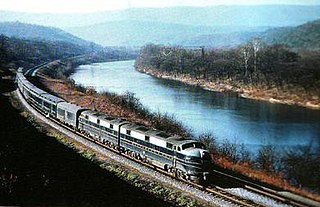
The Shenandoah was an American named passenger train of the Baltimore and Ohio Railroad (B&O), one of four daily B&O trains operating between Jersey City, New Jersey and Grand Central Station in Chicago, Illinois, via Washington, D.C., and Pittsburgh, Pennsylvania from the 1930s to the 1950s. Other B&O trains of that period on the route were the Capitol Limited, Columbian, and the Washington–Chicago Express. An alternate branch originated in Detroit and met with the Chicago part of the train at Deshler, Ohio, south of Toledo.
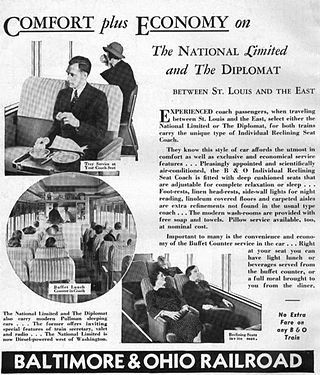
The Diplomat was a named passenger train of the Baltimore and Ohio Railroad (B&O) during the 1930s–1950s connecting New York City and St. Louis, Missouri, via Washington, D.C. Other B&O trains on the route during that period were the premier National Limited and the workhorse Metropolitan Special. The train was inaugurated in August 1930 after several changes to trains along the St. Louis Route. After World War II, the Diplomat operated as Train No. 3 westbound, and No. 4 eastbound. It was timed to provide connections to several western railroads that terminated in St. Louis, including the Frisco, the Santa Fe, Cotton Belt and Missouri Pacific, among others.
The South Wind was a named passenger train equipped and operated jointly by the Pennsylvania Railroad, the Louisville and Nashville Railroad, the Atlantic Coast Line Railroad, and the Florida East Coast Railway. The South Wind began operations in December 1940, providing streamliner service between Chicago, Illinois and Miami, Florida. This was one of three new seven-car, all-coach streamliners operating in coordination every third day along different routes between Chicago and Miami. The other two longest enduring Chicago-Florida trains were the City of Miami and the Dixie Flagler. The South Wind remained in service through the creation of Amtrak in 1971.
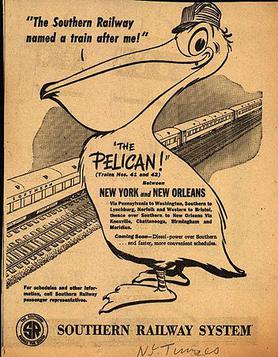
The Pelican was a named train of the Southern Railway which ran from New York City to New Orleans and back until 1970.
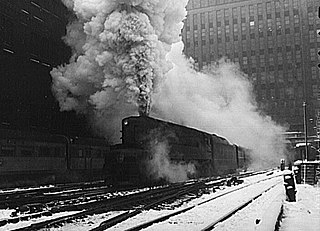
The Manhattan Limited was a passenger train of the Pennsylvania Railroad which served the Chicago—New York City route.

The Birmingham Special was a passenger train operated by the Southern Railway, Norfolk and Western Railway, and Pennsylvania Railroad in the southeastern United States. The train began service in 1909 and continued, with alterations, after Amtrak assumed control of most long-haul intercity passenger rail in the United States on May 1, 1971. The Birmingham Special is the namesake of the famed Glenn Miller big band tune "Chattanooga Choo Choo".
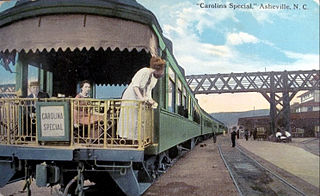
The Carolina Special was a passenger train operated by the Southern Railway between Cincinnati, Ohio and the Carolinas. It operated from 1911 to 1968. It was the last passenger train to use the route of the Charleston and Hamburg Railroad, which, as the South Carolina Canal and Railroad Company, began operation in December 1830, as one of the oldest railroads in the United States, and, by 1833, operated a 136-mile (219 km) line to Hamburg, South Carolina, on the Savannah River, the country's longest at that time. All Southern Railway Pullman service to Charleston rode over that historic, if bucolic, route from Branchville to the port city.
The Penn Texas was a named passenger train of the Pennsylvania Railroad that ran from New York City's Pennsylvania Station to St. Louis' Union Station from 1948 to 1970. The train also had a branch from Harrisburg, Pennsylvania to Washington, D.C., via York, Pennsylvania and Baltimore, Maryland. The train offered sleeping cars that would run continuous to different Texas branches to El Paso, Houston and San Antonio over the Missouri Pacific's Texas Eagle. Accordingly, this service was the longest distance that an American railroad offered for through sleeper service to the east coast, with exception of trains running from California to New York. Coach passengers heading to Texas would need to change at St. Louis Union Station. Throughout this period, the Pennsylvania's competitor, the New York Central Railroad operated a competing Southwestern Limited which also offered sleeping cars which would hitch with Texas Eagle trains.
The Southland was a night train between Chicago, Illinois and different points in western and eastern Florida from 1915 to 1957. In the early years it was called the New Southland. It was distinctive among Midwest to Florida trains as its western branch was the only all-season mid-20th-century long-distance train passing from Georgia to Florida bypassing the usual passenger train hub of Jacksonville Union Station. The main operator was the Louisville and Nashville Railroad, and pooling partners were the Pennsylvania Railroad, the Atlantic Coast Line Railroad and to lesser extent, the Wabash Railroad and the Florida East Coast Railway. For southeast bound -but not northwest bound- trips to Norfolk, Virginia, some coaches in 1946 diverged at Cincinnati along a Norfolk and Western Railway route. Northwest bound, travelers could switch trains at Cincinnati for heading towards Chicago.
The Southwestern Limited was a night train, as #205 of the Illinois Central Railroad in the Southeastern United States. Running on the IC subsidiary Yazoo and Mississippi Valley Railroad Vicksburg Division, from Meridian, Mississippi's Union Station to Shreveport, Louisiana's own Union Station, it was one of the few trains spanning the Mississippi River south of St. Louis, Missouri and north of New Orleans, Louisiana.
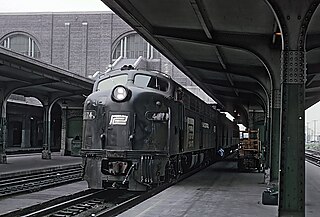
The Buffalo Day Express was a long-distance north–south Pennsylvania Railroad passenger train from Washington, D.C., to Buffalo, New York. It had a second branch that originated in Philadelphia, Pennsylvania, and at times, from New York, New York. In the southbound direction, the train ran by the name, Washington Express. It was the longest running of trains on the Washington-Buffalo route, north through central Pennsylvania on the Buffalo Line, operating from 1900 to the latter years of the 1960s, with a shortened segment until 1971.

Canton station, or Canton–Akron station, is a former train station in Canton, Ohio.
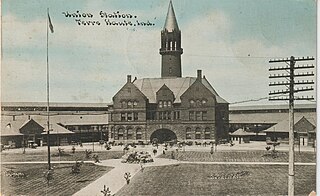
Terre Haute Union Station was a passenger train station located at Ninth Street and Spruce Street, Terre Haute, Indiana, serving riders for nearly 67 years. It was completed on August 15, 1893, at the cost of $273,000.
Springfield Big Four Depot was a Springfield, Ohio, passenger train station of the Cleveland, Cincinnati, Chicago and St. Louis Railway, commonly referred to as the 'Big Four Railroad.' Construction on the station began on November 22, 1909 and it opened for service in 1911, The brick structure was located at 202 Washington Street and Spring Street, east of the Big Four's previous station on the south side of Washington Street.















